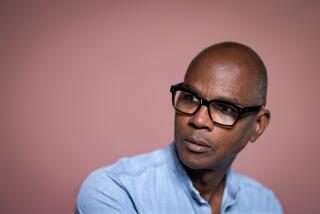ART REVIEW : THE MOUNTAIN ODYSSEY OF FERDINAND HODLER
- Share via
Something crisp and chilly as a winter’s day in the Alps envelops the landscapes of Ferdinand Hodler. There are 27 of them on view until May 24 at UCLA’s Wight Art Gallery. The event should be a welcome revelation about a highly inventive, somewhat isolated Swiss artist who has never been seen in any depth in these parts. Instead, everything about the show keeps the viewer at arm’s distance, making the art exceedingly hard to warm to.
A cool, greenhouse-like exhibition design begins with a row of delicate shrubbery against gray-white walls and traditional columnar moldings that all feels a bit like those new, airy restaurants around town--without the tables, of course. Pictures are widely spaced, and really it’s all quite lovely and serene, but the ambiance lacks intensity and you can’t tell if it’s the installation that sucks energy out of the pictures or if it just isn’t in them.
Artistically, this is one of those rare shows that actually lets you leave the gallery feeling let down, then jerks you back for a last look and the realization that Hodler was quite a terrific painter.
He was born in 1853--the same year as Van Gogh--and died in 1918. He was a contemporary of James Ensor of Belgium and Edvard Munch of Norway. Like them, Hodler is regarded as Post-Impressionistic in style and a forerunner of full-blown German Expressionism. He shared the traumatic childhood that seemed to dog so many of these artists. His parents and seven brothers and sisters died--mainly of tuberculosis--before he could escape his birthplace in the poorest section of Bern.
Unlike his contemporaries of the avant-garde, Hodler did not move to an art center like Paris, Munich or Vienna but remained mainly in Geneva, where he periodically ran afoul of the conservative art establishment. He did develop a reputation in the big cities and was especially appreciated in Germany, where he became a member of the Munich Secession and other artistic associations. Everything was fine until 1914, when he had the bad taste to protest the German bombing of Reims cathedral. He was expelled from German organizations and lost his public there.
Even when he had it, it was based less on his landscapes than on big allegorical figure compositions like “The Night,” which is about the only Hodler reproduced with any regularity in general texts on modern art. There are three figurative paintings in the present show--a Millet-like “The Reaper,” a suspicious and quizzical self-portrait and a symbolic “Intuition,” whose four female figures look like pastel dishrags. Even though the show is clearly labeled “landscapes,” it is a letdown not to have an introduction to his work in greater depth.
At a glance, the landscapes look overkeyed in color and painted to the kind of broad formula that was to dog conservative plein-air painting later here in Southern California. Hodler had a kind of engineer’s eye that mechanizes the pictures in the direction of American illustrator Rockwell Kent.
It doesn’t seem very promising at all and you begin to suspect it’s all just a part of the UCLA gallery’s recent attraction to between-the-cracks artists like Philip Evergood and schools like the Italian Impressionists.
Then you focus on a picture like the 1890 “At the Foot of the Petit Saleve,” noticing the feathery pinwheel brushwork and delicate multicolored lines, and how the whole hints of Teutonic lyricism mixed with Swiss practicality.
Nearby early pictures are certainly not Impressionist in the French sense but they are bright --usually dominated by a single hue like green or yellow--and every one a response to a real moment of light and air and time of day in a particular place. You hear green leaves rustling in summer stillness.
By 1901 Hodler is painting panoramas of Lake Geneva in broad tense bands where the lake looks frozen on a hot day and little clouds scud over the mountains like fluffy lambs. Maybe their tense horizontality reflects Hodler’s theory of “parallelism.” As time goes on, the lake keeps getting bigger. By 1910 it is Lake Thun with a massive mountain in the background. The lake has flopped up on the vertical plane and it’s all blurry aqua and pink, like a hysterical Mark Rothko. The big shark-toothed mountain in the background divides the composition symmetrically. We are already in the metaphorical world of Marsden Hartley or Georgia O’Keeffe.
Hodler remained a shade more literal than they, so his work flops between symbolism and depiction. That takes some getting used to, but finally we accept being in the presence of a full-blown nature mystic on a righteous rocky mountain high. He was attracted to Rosicrucianism, but his work is miles beyond any set doctrine.
He took real free-fall pictorial risks, like showing just the tips of the Monch, Jungfrau and Eiger summits above a smoky fog that takes up most of the picture. It was already 1908 and old Hodler was still ahead of the young Turks of German Expressionism.
Probably there is a lot of cultural symbolism, involving godheads and authority figures and a Swiss sense of transcendence in all those big mountains, that is completely lost in translation to our exotic beaches and palms. There is probably something personal about Hodler on a lonely odyssey, searching for his lost father. . . .
More to Read
The biggest entertainment stories
Get our big stories about Hollywood, film, television, music, arts, culture and more right in your inbox as soon as they publish.
You may occasionally receive promotional content from the Los Angeles Times.










